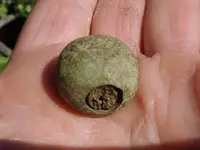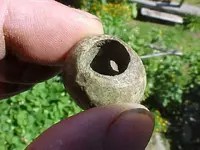goldnow
Sr. Member
Found this around a 200 year old house in Italy, though was not 1" down. It's surprisingly heavy for its size..26 grams..There are three holes, with one going through, and one from the top meeting the others.. The holes were filled with crude wood dowels, that fall out easily, now that it has dried for a few days after a water cleaning. The material has a brass/copper color to it, but feels like lead...There is no rust or corrosion....The sides are flattish...It is 7/8" on all of its sides....Thanks in advance for any ideas.








